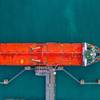In rough waters and heavy snow, a crew of budding professional mariners at the helm of the 565-ft., 17,000-ton Empire State VI prepared for docking at the Alfred A. Olivet Pier on the campus of the State University of New York (SUNY) Maritime College in Throggs Neck, NY.
Meanwhile, seasoned mariners monitor high-tech radar display systems that enhance safety and navigation in inclement weather and other conditions that reduce visibility. Some of them coordinate their tasks with partners who are busy operating electronic charting systems and evaluating the precise, up-to-the-minute data they generate.
While the description above has the flavor and feel of a ship at sea, don’t be fooled. It’s actually a snap-shot of what occurs on a daily basis at Maritime’s Center for Simulation and Marine Operations, the place where experienced professionals fine tune their navigational skills and neophyte mariners are groomed and prepared for the challenges at sea.
“At Maritime, we strive to provide a continuum of training that is based on the philosophy that experience combined with practice equals a greater degree of efficiency and success,” said Vice Admiral John R. Ryan, USN (Ret.), President of Maritime. “We achieve this by augmenting experience, whether you’re a professional working on a tanker, barge or tug or a Maritime student who has sailed on our annual eight-week, Summer Sea Term aboard the Empire State VI, with practice on the most advanced skill-building technology in the maritime industry.”
The main components of the Center include a full-mission bridge simulator and fully equipped, multi-station Electronic Chart Display and Information System and Automatic Radar Plotting Aides (ARPA) Labs.
Located in a commodious horseshoe shaped room with black painted walls, the full-mission bridge simulator is used to conduct specific missions or maneuvers operating sea-going vessels, from tug boats to barges to cargo ships, in just about any setting or weather. Consisting of the spectrum of navigational controls in the bridge of a ship, the area where steering, speed, navigation, meteorology and location is monitored, the simulator meets the training needs of the modern marine industry and is in full compliance with the regulations of the Standards for Training Certification of Watchkeepers (STCW).
The bridge simulator can be set up for group interactive exercises for specific training and certification or for individual hands-on familiarization of controls and equipment, self-test examination and knowledge assessment. It features radar displays, an ECDIS, vessel controls and navigational sensors. The simulator also produces all related visual and sound effects to create a realistic, professional virtual environment.
Astronomical settings include fair weather or storm clouds, bright sunshine, moon and stars in night scenes, all of which can be positioned according to time, date and geographic position. A three-dimensional sea model reflects the sky, clouds, sun, moon and stars with their lighting paths and responds to the wind, current, the motion of the ship and the Beaufort scale. Aids to navigation, including lighthouses, beacons and buoys, can be displayed to their correct color, sectoring and characteristics according to approved navigation charts.
These virtual effects can be changed during exercises. Local visibility can be adjusted due to low clouds, fog banks, thunderstorms, rain, snow squalls, etc. The level of illumination can change gradually with the transition from day to night and night to day, with the twilight period in between.
· The ARPA/Radar Simulator Lab is used to practice radar-based navigation in conditions of poor or limited visibility, narrow waterways or areas, such as ports and canals, with heavy traffic. Main PC-based simulators;
· simulated or stimulated equipment;
· access to world -wide database of radar scenes;
· simulation of a variety of real radars used onboard vessels;
· and STCW'95 compliant;
· compliance with international requirements.
The ECDIS simulator has been designed to meet the growing need for professional training of ECDIS operators. Skills gained using the ECDIS simulator include the enhanced operation of ECDIS equipment, the accurate assessment and employment of ECDIS-related information, and thorough understanding of the capability and limitations of ECDIS.
Through intensive training with the ECDIS, the mariner
· acquires a thorough knowledge and functional understanding of the basic principles governing ENC data and its proper display in ECDIS;
· demonstrates the proper use of the ECDIS equipment, including the use of navigational functions associated with route planning and monitoring; the ability to select, display, and interpret relevant information, and knowing what proper action to take in case of malfunction;
· build awareness of ECDIS-related limitations, particularly those associated with errors of interpretation, over-reliance, and complacency.
The Center also offers a comprehensive continuing education curriculum that includes certificate programs in marine surveying and emergency management.
Designed for Emergency Planners, Emergency Responders, Corporate Safety and Environmental Managers and Government Managers, the emergency management seminar is a series of courses focusing on the principles of emergency and crisis management. Program instructor Liam Murphy, Westchester County Office of Emergency Management, takes a broad look approach and discusses the issues and problems that face managers and responders in a wide range of crisis situations. Courses include the Principles of Emergency Management, Emergency Communications, Emergency Planning and Drills, Management of Environmental Emergencies and the Incident Command System. Cost for the program is $315 per person.
The marine surveying program is divided into three seminar tracks: Yacht Surveying, Commercial Surveying, and Cargo Surveying. Each track offers a comprehensive series of advanced courses, including preparing and interpreting the survey report, vessel construction and hull surveys, engine room surveys, expert testimony, cargo damage and surveying for claims. For experienced marine surveyors and specialists in marine insurance, marine claims and admiralty law, each two-day seminar is $395 per person.
Subscribe for
Maritime Reporter E-News
Maritime Reporter E-News is the maritime industry's largest circulation and most authoritative ENews Service, delivered to your Email five times per week










